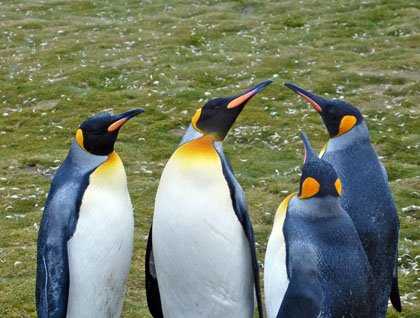I am tired. It has been a long day. But it is a pleasant, contented sort of tired that I share with my shipmates on National Geographic Explorer, as we pack all that we can into our days on the Antarctic isle of South Georgia.
We began at 5:00 a.m. as we boarded our Zodiacs at first light to land at Salisbury Plain, in the Bay of Isles. It supports the second largest colony of king penguins on South Georgia, with about 60,000 breeding pairs at last count. King penguins have a unique breeding system. The large, brown, furry-looking young that we call “Oakum Boys” were gathered in crèches in the center of the colony. They started as eggs that hatched last summer. They have already survived a South Georgia winter, with their parents making only occasional visits to bring food. A few more feeding visits and the young will be ready to take on their adult-type plumage. Now, they vigorously flap their developing flippers and utter their plaintive whistles, each of them unique, that the parent birds will use to find their own young in the melee. Around the periphery of the colony were groups of molting adults, doing pretty much nothing as new feathers replaced the old. Following their molt, they will lay this year's egg. Finally, groups of courting adults pranced about, chest out, stretching as tall as they might, and occasionally whacking the others with their hard flippers.
Our afternoon stop took us to an offshore island, Prion Island. It would be nice to think that all of South Georgia is as it has always been, shaped only by nature and evolution, but that is not the case. Brown rats were inadvertently introduced by the sealers who arrived soon after Captain James Cook's description of the abundance of "sea bears" (fur seals) found here. The rats feed on the eggs and young birds. Where there are rats, many species can no longer breed. Fortunately, some offshore islands like Prion Island have avoided the scourge of rats. Here we find breeding colonies of the magnificent wandering albatross, with the longest wing span of any bird, and here we find the South Georgia pipit, the only songbird or perching bird to breed in the Antarctic. They are symbols of what South Georgia used to be, and what we hope it will become when the ambitious project of the South Georgia government to remove the rats has come to fruition.
We walked up a wooden boardwalk on Prion Island to reach the area of nesting albatross. Along the way, pipits rose into the wind and then descended, like skylarks, while giving their lovely trill. The young albatross come from eggs that were laid by adults last summer. Now, the young birds are as big as their parents, and their juvenile down is being replaced by adult-type feathers. Several birds near the viewing platform were spreading their long wings, developing their flight muscles and learning to use the wind. They seemed only days away from their first flight. When they leave Prion Island, they will spend five or more years at sea before, we hope, they return to South Georgia to join the breeding population. May they find it an even better place, perhaps to colonize the newly rat-free areas.







